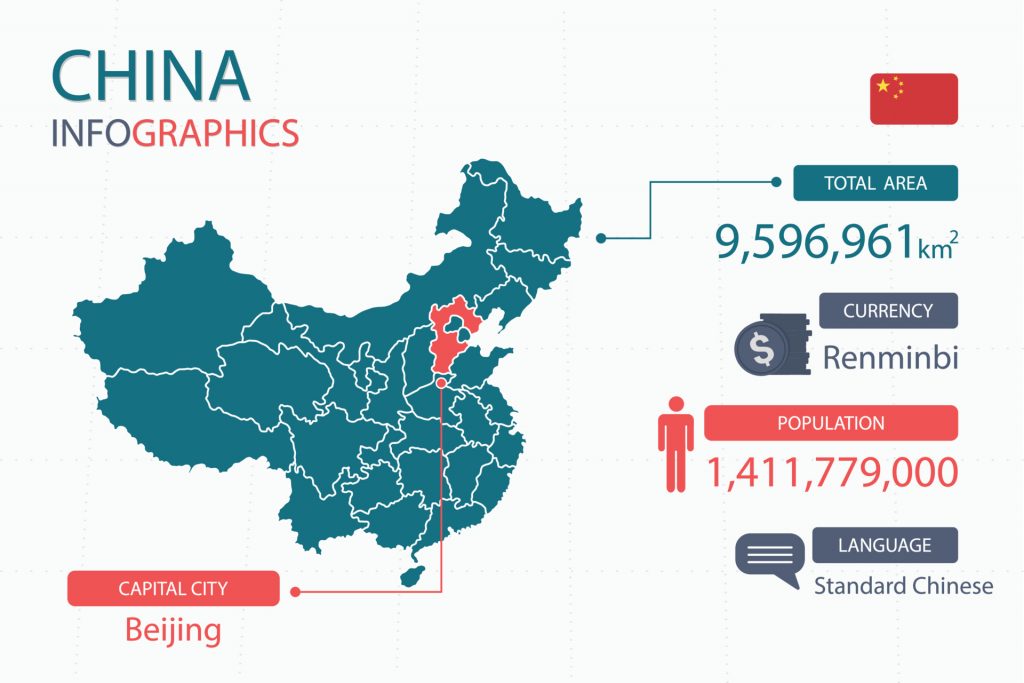The origins of the Chinese Language
Written Chinese are considered logograms, where in general, the characters represent concepts and ideas. It is categorized as either traditional or simplified with the latter heavily influenced by reforms in the writing system made at the governmental level and promoted since the 1950s and 1960s. Other iterations of Chinese writing have also spread to neighboring countries and the languages of these countries have adopted these elements of the Chinese writing system into their own. Simplified Chinese is officially used in Mainland China and Singapore, while Traditional Chinese is used in Taiwan and Hong Kong.
Written Chinese can either be written from left to right, read from the top to the bottom of the page, or vertically with the columns of text occurring from right to left. Perhaps the most notable characteristic of the script is the amount of characters that users of the language have to know in order to be considered literate. 6,000 characters are designated as common with thousands more required to read more technical texts. The script normally does not denote sounds but rather concepts represented in iconic form, something that vastly differs from more Western scripts. A minority of the characters do, however represent sounds. Many changes of the script have occurred throughout the history, which may have buried the original meaning or sounds of the characters.
The nature of the script makes learning Chinese for those who are not familiar with Chinese characters a daunting task. In addition, the use of certain characters to convey nuances in the writing that might not be conveyed purely through speaking adds more considerations for those who have to deal more exclusively with written genres, such as writers and translators.
The Chinese language has a long history that reflects the cultural shifts that have occurred throughout the Sinosphere throughout history. Furthermore, the different rates and paths of development between written Chinese and spoken Chinese make it quite an interesting artefact of study in historical linguistics. In terms of speaking, this history includes the development of dialects of Mandarin, Cantonese, Wu, and more. Some are mutually intelligible while others are not and have evolved in different ways. Writing, however, has evolved more steadily and in a more standardized fashion. Thus, while certain speakers might use dialects that are not mutually intelligible, there is a common ground in terms of written form.
The history of the Chinese language can generally be divided into three eras. Old Chinese, also referred to Classical Chinese or archaic Chinese, was the language that was used during the beginning of the Zhou Dynasty. Not much known exists about the actual spoken language as it has mostly been analyzed from a written perspective, even though clues into aspects such as pronunciation and dialectal differences can be drawn from the literature and poetry at the time, as well as from other languages that were heavily influenced by Chinese, such as Korean, Japanese, and Vietnamese. During this time, the oral language was one where tone did not play much of a role. The start of the character system also emerged, with most characters being basic logograms, corresponding to basic elements that were important for everyday living as well as literary and poetic expression. As time went on, these logograms evolved into the more complex and nuanced characters that we see today.
The nature of the script makes learning Chinese for those who are not familiar with Chinese characters a daunting task. In addition, the use of certain characters to convey nuances in the writing that might not be conveyed purely through speaking adds more considerations for those who have to deal more exclusively with written genres, such as writers and translators.

The Chinese language has a long history that reflects the cultural shifts that have occurred throughout the Sinosphere throughout history. Furthermore, the different rates and paths of development between written Chinese and spoken Chinese make it quite an interesting artefact of study in historical linguistics. In terms of speaking, this history includes the development of dialects of Mandarin, Cantonese, Wu, and more. Some are mutually intelligible while others are not and have evolved in different ways. Writing, however, has evolved more steadily and in a more standardized fashion. Thus, while certain speakers might use dialects that are not mutually intelligible, there is a common ground in terms of written form.
The history of the Chinese language can generally be divided into three eras. Old Chinese, also referred to Classical Chinese or archaic Chinese, was the language that was used during the beginning of the Zhou Dynasty. Not much known exists about the actual spoken language as it has mostly been analyzed from a written perspective, even though clues into aspects such as pronunciation and dialectal differences can be drawn from the literature and poetry at the time, as well as from other languages that were heavily influenced by Chinese, such as Korean, Japanese, and Vietnamese. During this time, the oral language was one where tone did not play much of a role. The start of the character system also emerged, with most characters being basic logograms, corresponding to basic elements that were important for everyday living as well as literary and poetic expression. As time went on, these logograms evolved into the more complex and nuanced characters that we see today.
Middle Chinese usually refers to the language used between the 6th and 10th centuries, and these are more similar to the Chinese varieties of language that are found today. There was development of tones and vocabulary. The writing system was also further refined, and more similarities can be seen from the writing system at this time to the writing of contemporary Chinese.
Modern Chinese remains an extremely important language. With the sheer number of speakers in a number of countries and with literacy rates having increased significantly in the past years, Chinese remains a vital mode of communication.
The number of Mandarin speakers continue to increase as education in countries outside the Sinosphere emphasize it as a foreign language, especially in the United States and European countries. Moreover, it’s influence on global politics and business, as well as its cultural spread makes is a vital language of the world.
When non-Chinese speakers think of Chinese, they think of the massive amount of characters in the script of course, which was described above. But also, it is the prototypical example of a tonal language, where the change of a syllables tone can change the meaning of words. Another interesting characteristic of the Chinese language, especially in Mainland China, is the regulation and standardization of it. The Chinese language tends to have less loan words as Chinese versions of the words are created and promoted within the education system.
What’s the difference between Simplified Chinese and Traditional Chinese?
Sometimes, people are confused between Simplified Chinese and Traditional Chinese. In addition, due to the variety of dialects that exist both in Mainland China, and other Chinese-speaking territories, the linguistic atmosphere in the Sinosphere is quite complicated to people from the outside.
Simplified Chinese and Traditional Chinese refer to the writing systems and would be more accurately referred to as Simplified Characters and Traditional Characters. As the name states, Simplified Characters are simplified versions of Traditional Characters, which tend to have more strokes, a more complicated stroke order, and more. The characters were simplified in the People’s Republic of China by the government and used in printing starting in the 1950s as a way to improve literacy rates, as they were deemed easier to learn and read.
Simplified Characters are used mainly in Mainland China, Singapore, and the Chinese community in Malaysia. Traditional Characters are currently used in Taiwan, Hong Kong, and Macau, as well as many communities of overseas Chinese, even though this is changing as immigration patterns change.
Sometimes, people confuse the terms Simplified Chinese and Traditional Chinese with spoken dialects. However, Simplified and Traditional do not refer to the spoken language but specifically to writing systems. Chinese dialects refer to the regional varieties of Chinese spoken in Chinese speaking regions. These include Cantonese, Hokkien, Wu, and many more. Linguists estimate there to be hundreds of varieties. Some major dialects, while called dialects for political reasons, are considered languages by the people who speak them and have a larger media presence, and political sway in terms of administrative use. This is especially true of Cantonese where a large movie and music industry exist.
VEQTA can provide you with a perfect Chinese translator for your Chinese translation, English to Chinese translation and Chinese to english translation for the your targeted locale. Our translations to Chinese are created with your target audience in mind to meet your expectations.
If you need to translate Chinese – Get in touch today!
A dedicated team of Chinese translators who combines Experience, Specialized Subject Matter Expertise with Translation Practices to deliver quality second to none.
Chinese Subject Expertise
Chinese Translators
Chinese Editors
Chinese Copywriters
Chinese Reviewers
Chinese Voice dubbing
Chinese Subtitling
Chinese Transcription


